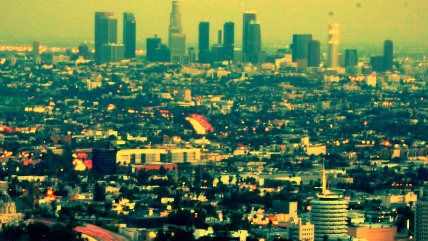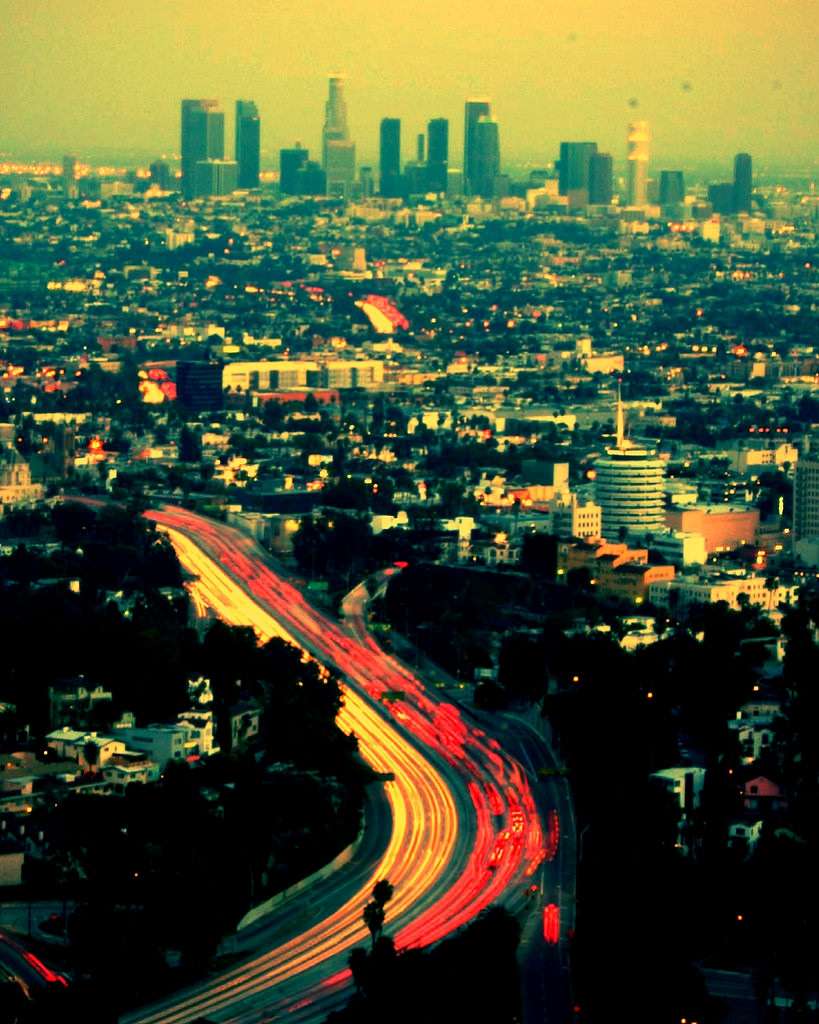Los Angeles Is Killing Itself
The romantic, popular conception of the city bears increasingly little resemblance to Los Angeles today.


Los Angeles hit peak swagger in the mid-1980s. After a decade of dwindling population, Los Angeles County was again gaining, about 120,000 people per year. Hollywood had near-perfected the summer blockbuster. The city's downtown subway system was finally completed. And a Soviet-bloc boycott had left the L.A.-hosted 1984 summer Olympics to serve as an ostentatious demonstration of American exceptionalism.
But the romantic, popular conception of the city that solidified in those years bears increasingly little resemblance to Los Angeles today.
The definitive rundown of L.A.'s problems comes courtesy of the Los Angeles 2020 Commission, an independent 13-member body lead by former U.S. Commerce Secretary Mickey Kantor. The commission released a pair of reports earlier this year which provide a precise—and surprisingly strident—diagnosis. L.A. suffers from a deluxe-size version of the vicious urban feedback loop that's already swallowed up several smaller cities in California: a shrinking job market, rapidly escalating public pension costs, and widespread deterioration in general infrastructure.
Los Angeles is the only large metropolitan area in the country to register a net jobs decline over the past two decades. While national employment has jumped by 20 percent since 1990, L.A.'s has dropped by 10 percent.
L.A.'s middle class is shrinking, with citywide median income falling steadily since 2007. And L.A. now has the highest poverty rate among any major American city.
These trends are partially attributable to the lingering effects of the financial crisis and broader transformative forces affecting the entire national economy. But, as the Commission report makes abundantly clear, these have been massively exacerbated by City Hall.
Just consider these two facts about the L.A. fire department:
- Its personnel recently secured a 26 percent uptick in their total average compensation. This package now sits at well over $200,000 a year, including $106,000 in salary and $65,000 in retirement contributions and otherwise unspecified "human resource benefits."
- L.A. firefighters still regularly use paper maps. A couple years ago, the department got called to an address in the community of Woodland Hills that was established after the map they were using had been printed. The engine lost its way, the fire raged unabated, and several people died. The victims' families successfully sued the city for millions… Then, a year later, the same thing happened again.
That same endemic bureaucratic incompetence has left Los Angeles' public school system as one of the most dysfunctional in the country. Fewer than half of its high-school students are even proficient in English. Less than 60 percent graduate. And only about a third complete the course requirements needed to qualify for admission into the state university system.
These failures are not a function of scarce resources. (When are they ever?) Municipal school authorities run with an annual operating budget of $6.47 billion; with 640,000 K-12 students in the system, that's over $10,000 per head. The big problem is that the L.A. Unified School District is institutionally allergic to experimentation. High performing charters like KIPP Academy have a tough time scaling up. Low-income schools aren't encouraged or allowed to incorporate targeted innovations—like longer class days and truncated summer breaks—that have shown promise in closing the achievement gap. Incompetent administrators are almost never held accountable.
The general city budget certainly isn't suffering from scarcity either. In 2011, municipal revenues were only down about 4 percent from their 2008 peak. But those dollars that aren't lost into the bureaucratic abyss are largely gobbled up by exploding public employee pension expenses. Back in 2002, pension costs accounted for about 3 percent of the city's budget. Since then, they've grown 25 percent per year. Now, they constitute 18 percent, totaling $1.3 billion annually.
Meanwhile, city officials are neglecting basic public infrastructure investments that even the most ardent libertarian could love, such as road improvements. Deteriorating street conditions and perpetually delayed highway expansions have exacerbated already horrific traffic congestion and driven up commute times. The average LA worker now spends about an hour a day getting to and from work. About 12 percent spend two hours or more—fully four percentage points above the national average.
Long commutes don't just suck up otherwise economically productive hours of the day, they also kill human happiness. Research has linked commuting with decreased life satisfaction and heightened anxiety. (Long commutes also have the unfortunate effect of propping up the mind pestilence that is political talk radio.)
City leadership has not exactly demonstrated bold leadership in face of all these profound challenges.
L.A. just got off eight years of the uniformly disastrous mayorship of Antonio Villaraigosa, whose only evident talent is self-promotion. This a man who should have risen to no higher station than moderately successful late-night infomercial pitchman. Yet the L.A. voting public freely elected him to office. Twice.
An investigation from LA Weekly at the end of his first term found he spent just about 11 percent of his working days on direct city business. The rest was occupied with banquets, ceremonies, photo-ops, ribbon cuttings, and other meaningless masturbatory activities of mayoral politics. Villaraigosa's bloated staff included 931 deputy mayors. He racked up a $100 million budget deficit. And, you might be shocked to learn, he abused his station for personal gain. Villaraigosa was eventually forced to shell out $42,000 in fines for illegally securing free concert and sports tickets.
Villaraigosa was term-limited out of office last year and replaced by Eric Garcetti, a man embodying the cool, non-threatening technocratic enthusiasm befitting a Rhodes Scholar. He's the natural counterbalance to his predecessor's vacuous flash. It's fair to say Garcetti is not instantly repulsive.
But whatever his merits, the new mayor seems highly unlikely to affect substantial change. Yes, Garcetti may well be able to broker some targeted fiscal reforms and slightly ratchet back the pension problem. But he's operating under clear political incentives to avoid serious structural shakeups. And mayoral power is, by design, tightly circumscribed.
The primary drivers of Los Angeles' fate are unsexy city departments, council staff, and administrators. As the Milken Institute's Kevin Klowden, who contributed to the L.A. 2020 report, told me: "It boils down to if you can change how the bureaucracy works." It's improbable the city can pull that off. Perhaps that's a pessimistic take, but does the recent history of Los Angeles justify anything else?


Show Comments (219)